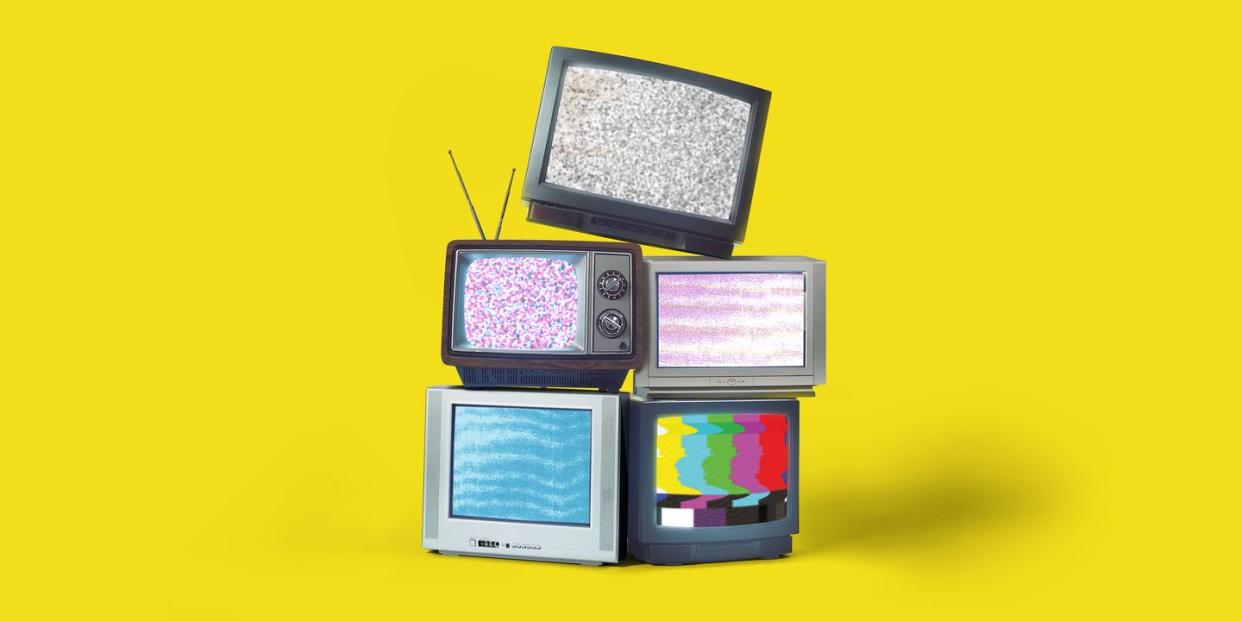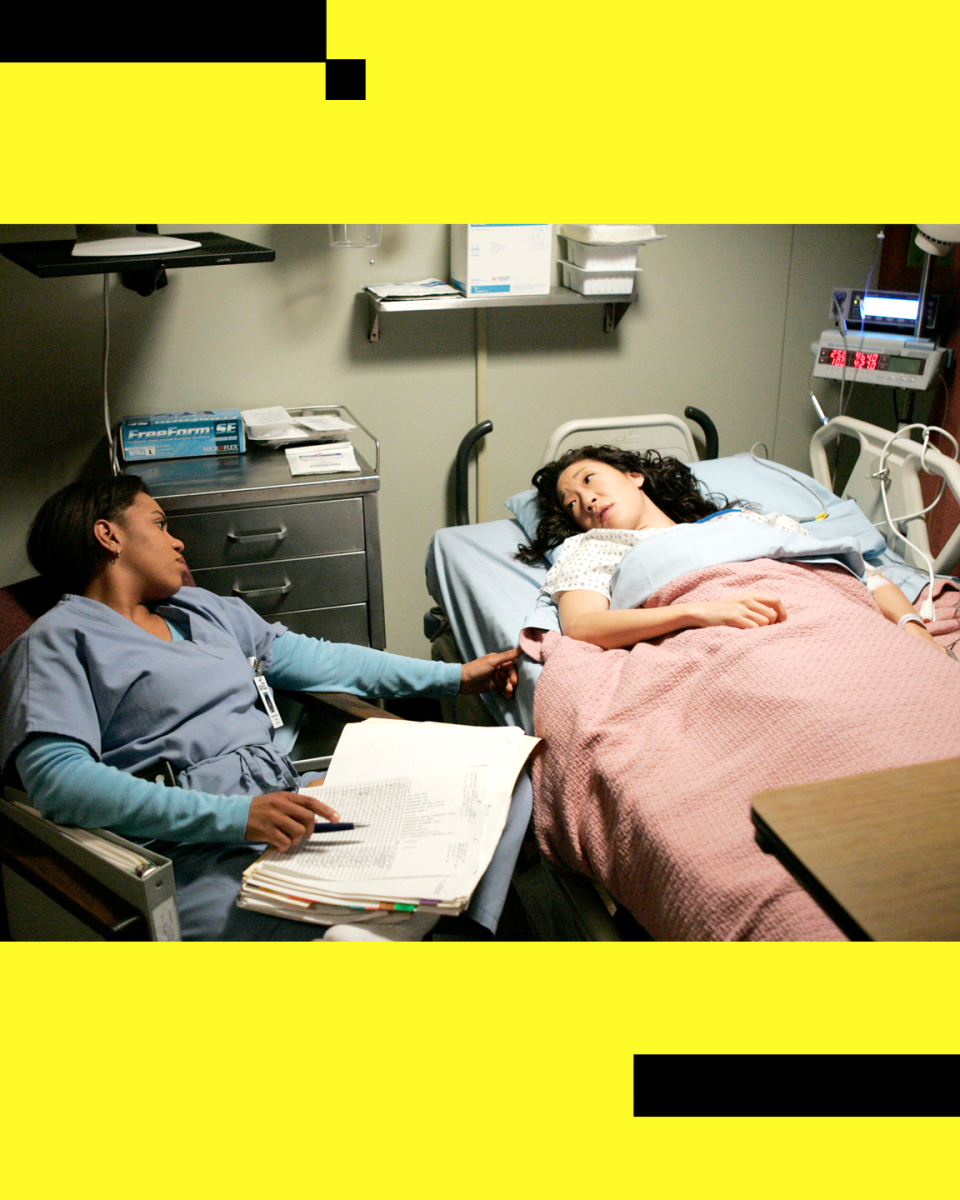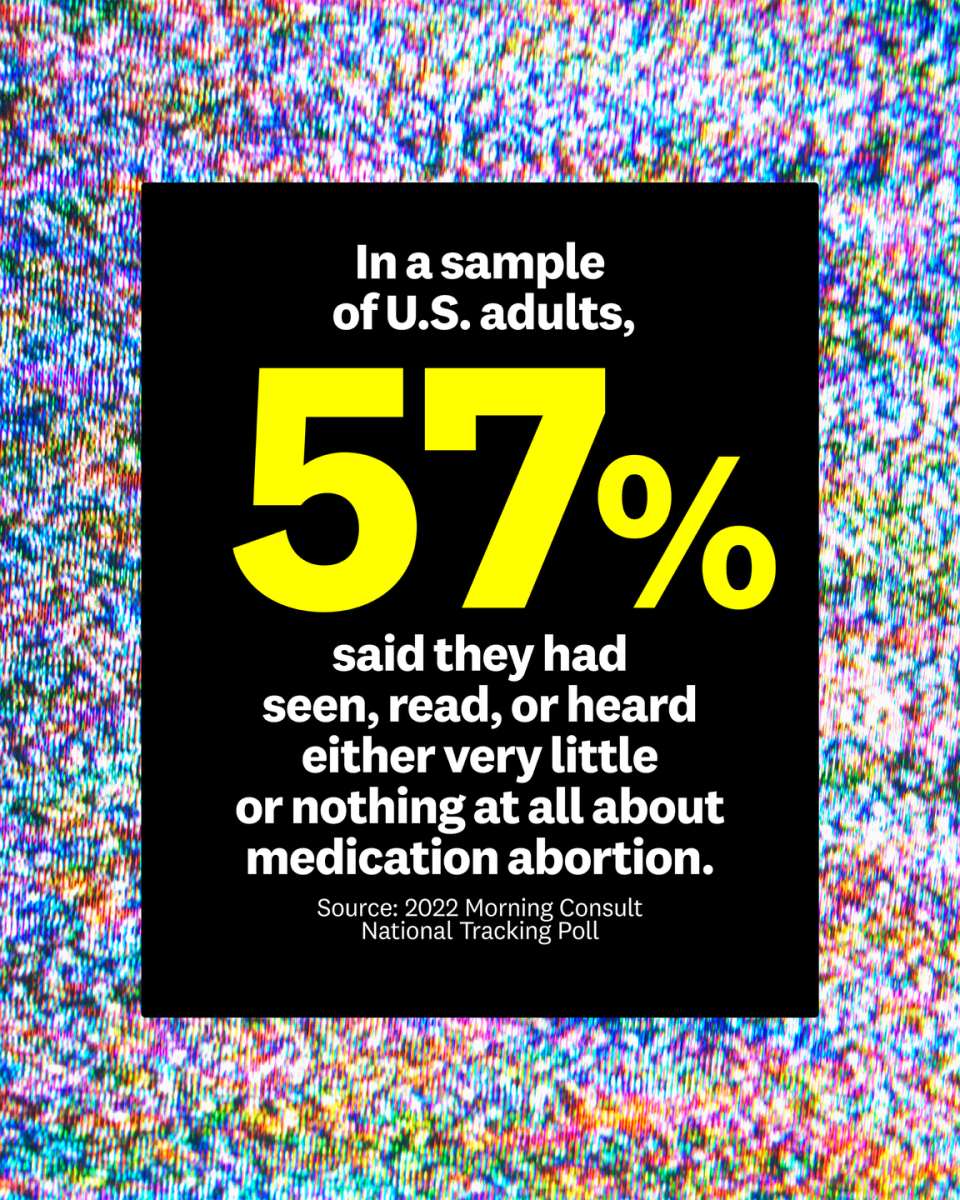Seeing An Abortion On TV Should Be As Mundane As Pumping Gas

When it comes to popular movies or TV shows, you can press play on a scene or an episode you’ve never seen, mute it, and still pinpoint exactly when a character decides to have an abortion, says Steph Herold, MPH, a researcher with Advancing New Standards in Reproductive Health (ANSIRH), an abortion research group.
The woman on-screen will likely be young and white. She’ll be upset. She can produce $600 on a moment’s notice and is quickly seen by a doctor. The clinic is somber, and everyone is cold and distant. A sad song plays as the tired, gloved professional readies their procedural tools. A single tear escapes the character’s eye because abortion is always just a little bit devastating. The scene fades, the credits roll, and next week our heroine will return, unchanged.
Fact-check: This isn’t what abortion really looks like. At all. The abortion portrayals we’re seeing on TV and in movies don’t tell the full, accurate story of this safe, common procedure.
In the U.S., one in four women will have an abortion by the time they are 45, and this statistic doesn’t include trans and non-binary people. Abortion patients can be of any race or ethnicity and might be parents, middle-aged, rich, poor, able-bodied, disabled, or neurodivergent, and they come from all over. Abortion is quick and essential health care—but these aren’t the stories Hollywood is typically telling, and that’s a bigger problem than you might realize.
When popular media doesn’t tell abortion stories accurately and responsibly (by showcasing the extremely wide variety of abortion experiences out there) and continues to portray old tropes that don’t reflect the majority of abortion experiences, it has a real negative impact.

A TV show or movie might be the first time someone sees an abortion, Herold explains, and the accuracy (or inaccuracy) of the depiction affects people’s perception of abortion, an aspect of reproductive health care that’s already steeped in misinformation.“[Media] can reflect societal myths, and it can critique them,” notes Herold. While research shows that media depictions are unlikely to flip anti-abortion voters, TV shows and movies can play a role in humanizing abortion and be incredibly supportive to those who’ve had one, if they’re portrayed compassionately.
“TV shows and movies can address the isolation, judgment, and fear surrounding abortion and provide audiences with emotional blueprints for how to support a loved one before, during, and after an abortion,” says Herold. “These plotlines can help those audiences feel less ashamed about their own abortions. It can help us feel seen and heard.” And storylines that include abortion are becoming more common.
In 2022, there were at least 60 abortion portrayals in movies and TV shows, up from 47 in 2021, according to a report from the ANSIRH Abortion Onscreen Database. Abortion is becoming more visible, but the scenes still don’t tell the whole story.
It’s nearly the one-year anniversary of the overturning of Roe v. Wade, which had granted the right to an abortion for the past half century. On June 24, 2022, the U.S. Supreme Court ruled in Dobbs v. Jackson Women’s Health Organization—a case that dealt with Mississippi’s 15-week abortion ban and ultimately challenged Roe. The overturning led to a cascade of state abortion bans and restrictions that have limited access for millions of women, leaving folks feeling more anxiety around what their experience will look like if they find themselves needing this kind of reproductive health care.
Providers, activists, and researchers agree that our media needs to present more abortion stories that reflect reality, says Herold, to help to cut down on the stigma and fear that unnecessarily and increasingly surrounds abortion in our political climate. Hollywood has a long way to go, but you can find these narratives if you know where to look (more on that later). First, the history of abortion storytelling, what it’s gotten right and (mostly) wrong, and why that matters.
It’s been more than a century since the first abortion was mentioned in a movie.
An on-screen abortion discussion made its medically inaccurate debut in Where Are My Children? (1916), which spun a tale of abortion-induced infertility. In the ensuing 50 years, abortion was mentioned only a whopping two times in a TV show before the sitcom Maude came along in 1972.
In the show, Maude, a 47-year-old grandmother, discovers she is pregnant and spends an episode contemplating ending the pregnancy. Abortion, newly legal in New York State when the episode aired, was taboo and dangerous when Maude was growing up. Her adult daughter, Carol, reassures her that now, “it’s as simple as going to the dentist.”
Maude ultimately has the abortion off-camera, saying she is too old to start parenthood all over again. The show was ahead of its time, portraying a very real situation and statistic: Most people who have abortions in real life are already parents.
By the 1990s, more characters contemplated abortion, but most decided against it or were conveniently rescued by a miscarriage or an unexpected change of circumstance.
For example, Roseanne’s (1994) titular sitcom character, a working-class mother of three, contemplates an abortion when she learns the fetus may have an abnormality. But she’s saved from making a decision because it turns out to be one big miscommunication.
In another scenario in 2001, Sex and the City’s single, successful attorney, Miranda Hobbs, learns she is pregnant after sleeping with her ex-boyfriend. She considers an abortion but decides to continue the pregnancy, saying it might be her only shot at motherhood. The trope inadvertently tells the audience that all women inherently want to be mothers and that abortion is a last resort.
“Now, we see a lot less of that,” Herold says, referring to portrayals of women’s indecision. “The drama is: How is she going to get the abortion? Who is she going to tell? How is it going to affect her relationships?”
This is a good thing, says Herold. Stories need drama, but it doesn’t have to center on the physical aspects of the abortion itself, or the decision’s morality. Instead, the drama may now surround the real barriers to accessing abortion that people face today.

But in more contemporary portrayals of abortion, creators are still missing the mark.
When it comes to who gets abortions, how they get abortions, and the normalcy of the decision, movies and TV shows tend to use the same old tired tropes. Typically, only two kinds of characters get or consider abortions: the promiscuous bombshell who struggles with the choice, like Marilyn Monroe in the film Blonde (2022) and Cassie Howard in the TV show Euphoria (2019), or a type A go-getter who chooses between motherhood and her career, like Cristina Yang in the hospital drama Grey’s Anatomy (2011) and Olivia Pope in Scandal (2015).
And despite the diversity of women in clinic waiting rooms, that’s not what is typically seen on TV. White women make up 33 percent of abortion patients but 58 percent of all abortion plotlines in 2022.
Additionally, when abortion is depicted as a white women’s issue, it perpetuates the myth of the “Perfect Abortion Patient.” Euphoria (2020) provides a perfect example of this trope. Cassie, a “promiscuous” cisgender, white teenager is crushed over her decision to have an abortion. The abortion provider is unfazed by her baby-faced, glassy-eyed agony, and the procedure seems to take hours.
In Little Fires Everywhere (2020) we’re introduced to Lexie Richardson, a wealthy white teenager popping into Planned Parenthood and throwing Pearl Warren, her Black friend, under the bus when she uses Pearl’s name for the appointment. Euphoria’s Cassie and Little Fires’ Lexie are both presented as troubled but ultimately sympathetic characters—ones who just got unlucky and then had to face traumatizing consequences. In these stories, abortion is framed as a repercussion that shouldn’t be a normal part of life and could have been avoided if these teens had been less sexual and more responsible.
Medication abortions are actually the most common way to end a pregnancy, but you wouldn’t know that from watching TV.
Movies and shows “always focus on the extremes instead of what actually goes on: a boring abortion,” says Iman Alsaden, MD, chief medical officer at Planned Parenthood Great Plains and an abortion provider in Kansas.
Medication abortion, which a person can administer themselves in their own home, is actually the most popular form of abortion, accounting for more than half of abortions in the U.S. But only 6 percent of abortion plotlines in 2022 depicted a character having a medication abortion, per ANSIRH.
That 6 percent is small but mighty. Station 19 and Grey’s Anatomy both featured candid dialogue about accurate medication abortion protocol. It was historic: Two prime-time network shows affirmed that medication abortion is safe and easy to their millions of viewers. While only one plotline ends in a medication abortion, the characters know it is an option, and the viewers do too.

[/image]
Still, medication abortion’s absence on our screens directly reflects the lack of awareness most people have about this safe abortion method. In a large sample of U.S. adults, 57 percent said they had seen, read, or heard either very little or nothing at all about medication abortion. This lack of knowledge allows the ongoing legal and political battles over the availability of abortion pills to be rife with misinformation, despite decades of science and research that prove otherwise. This gap in abortion portrayals is leaving people unaware of their options, and misinformed about a medication that is safer than Tylenol.
People feel a variety of emotions about their abortions, but media tends to portray only dark feelings.
Characters are mostly conflicted and then remorseful. “These patients are depicted as having such a hard choice, and they had to talk to their friend, talk to their mom, talk to their pastor, talk to whoever. Those patients [in real life] are few and far between,” Alsaden says. In fact, 99 percent of women who have abortions report it was the right choice.
The trope that abortion patients are always regretful and always unsure, introduces an unnecessary hurdle for people figuring out their next steps, and it contributes to the stigmatization of those who don’t feel it’s a difficult choice. And abortion stigma can be incredibly harmful to mental health.“[My patients] know what they need, and they know what’s right for them,” Alsaden adds. “And people change their minds about that so rarely by the time they show up to our clinic.”
Newer characters have helped fill this gap. Amazon’s dramedy The Marvelous Mrs. Maisel (2023) introduces Mei Lin, an Asian woman trying to become a doctor, who decides to have an abortion in the 1960s. While her abortion isn’t shown, show creator Amy Sherman-Palladino and the series’ producer, writer, and director, Dan Palladino, make sure the audience knows Mei is confident in two things: her big dreams and her desire not to be pregnant. She doesn’t feel bad about that, and she shouldn’t.
But show creators don’t always need to frame an abortion decision as a means to future achievement. Shrill (2019) makes the point that not being ready for pregnancy or parenthood is reason enough. The show’s main character, Annie Easton, a writer, discovers she’s pregnant and contemplates parenting with her friend-with-benefits, a noncommittal underachiever she’s been sleeping with for six months.
Annie goes through with the abortion—an easy, in-clinic procedure—and spends the rest of the series deepening the love and commitment she has to herself and others.
The message in both shows is that there can be joy and freedom in bodily autonomy. Abortion is really just that: a singular, yet important, health care decision, one of many significant medical decisions people make over their lives.
Recently, storylines have depicted characters who are facing barriers to abortion, both before and after the fall of Roe.
As attacks on access have increased over the past few years, more films and TV shows are depicting the logistical struggles of getting an abortion, with a historic third of all abortion plotlines in 2022 depicting a legal barrier to abortion, according to ANSIRH.
Unpregnant (2020) jumped on it. The comedy follows two best friends, Veronica and Bailey, as they drive from Missouri to New Mexico so Veronica can get an abortion without her parents finding out.
Three years after the release of the film, Veronica’s experience is increasingly common. She’s steady in her decision, but challenged in making it happen.
“When she found out she was pregnant, she, like me, knew what she wanted to do,” says Unpregnant director Rachel Lee Goldberg. “And she was very clear on that. There was no pro and con list. There wasn’t a lot of hand-wringing.”
Unpregnant demonstrates the power of having writers and directors who’ve actually experienced abortion. They know which aspects of an abortion are actually dramatic and which ones typically aren’t. Showing the struggle some patients have in accessing care can help viewers see why current bans are cruel and unjust. It’s easier for folks who might not initially understand the issue to empathize with a character they’ve gotten to know over several hours on their screens at home.
Newer films are also speaking to the long history of abortion barriers. Call Jane (2022) begins in 1968, before Roe legalized abortion, and documents how women provided each other with safe, illegal abortion care. This film depicts the battle for care that so many women are now facing again.
With more abortion stories on air than ever before, portrayals have room to grow and evolve.
There are also organizations that are keeping track of the state of media depictions, offering advice and critiques. ANSIRH maintains a comprehensive database of abortion portrayals in media (you can search for episodes and movies based on genre, character age and race, health outcome, legality, location, and time setting), and WeTestify presents annual awards to television shows and movies that break down stigma and provide positive portrayals.
One of the winners, the show P-Valley (2022), which earned the Best In-Clinic Abortion Depiction Award from WeTestify for an episode called “Jackson” in the second season, follows a woman and her daughter during a 24-hour waiting period at the Jackson Women’s Health Center in Mississippi. Mercedes, the mom, helps her teenage daughter, Terricka, navigate that abortion journey. Mercedes, who was a teen mother, reflects on her relationship with her own mother as she gives Terricka space to make her decision.
“All I’ve ever wanted is for you to have choices,” Mercedes tells her daughter.
Ultimately, Terricka elects to have the abortion. It’s a decision not to become a parent as a teenager. It’s also a decision to stop a cycle of poverty and trauma.
This depiction is a powerful example of how abortion stories can be used as commentary on social issues, generational traumas, and the connections our decisions have to the past and the future.
There will never be a “perfect” abortion portrayal, because abortion experiences are individual and nuanced.
The drama, however, should continue moving away from the act itself. What makes these stories interesting are the people in them: the patients, their loved ones, and the beauty of someone finding their voice and power.
“I want her to walk into the clinic,” says Alsaden of her dream portrayal. “I want her to play Candy Crush on her phone while she’s waiting. I want her to have a very fast, easy abortion and I want her at the end to say, ‘That’s it?’ And I want to see that because that’s the experience of most people. It’s like, I need to go to the gas station to put gas in my car and I need to go get my abortion.”
Realistic abortion stories tell us about kindness, community, self-discovery, and sometimes, that thing you had to do on a Tuesday in 2016. These abortion stories are revolutionary, and they deserve a prime-time spot on everyone’s screens.
You Might Also Like

